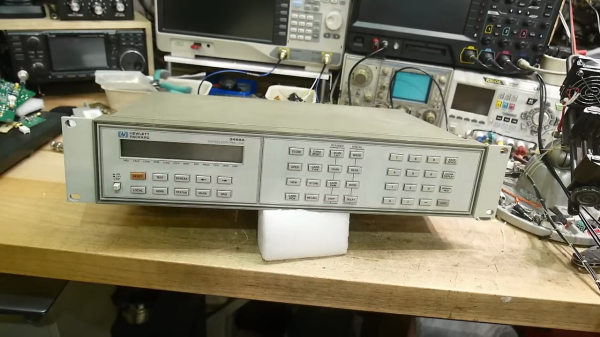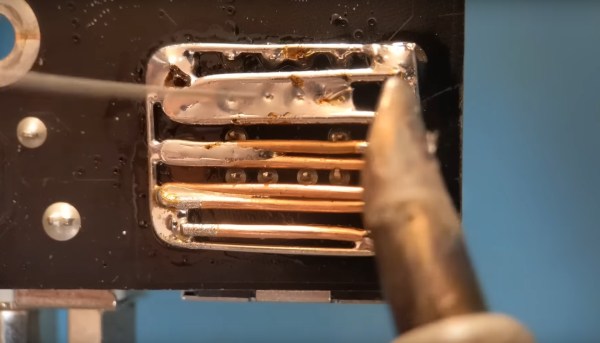[IMSAI Guy] has an old HP 3488A Switch Control Unit that he wants to dismantle for parts ( see video below the break ). The 3488A is pretty simple as far as HP test equipment goes — a chassis that can hold various types of relay cards and is programmable over GPIB. He notes up front that these are plentiful and inexpensive in the used test equipment market. Continue reading “HP 3488A Teardown, Dismantled For Parts”
Day: March 17, 2023
The Blue Soup Saga Is One Beefy Mystery
Beef soup! You’d normally expect it to be somewhere from reddish-brown to grey, depending on how well it was cooked and prepared. However, strangely, an assistant professor found the beef soup in their fridge had mysteriously turned blue. That spawned an investigation into the cause which is still ongoing.
[Dr. Elinne Becket] has earned her stripes in microbiology, but the blue soup astounded her. Despite her years of experience, she was unable to guess at the process or a source of contamination that could turn the soup blue. Indeed, very few natural foods are blue at all. Even blueberries themselves are more of a purple color. The case sparked enough interest that [Elinne] went back to the trash to collect photos and sample for research at the request of others.
Thus far, metagenomic DNA analysis is ongoing and samples of the soup have been cultivated in petri dishes. Early analysis shows that some of the microbes form iridescent colonies, Another researcher is trying to determine if the bugs from the soup can make blue color appear on soft cheese. There’s some suspicion that a bacteria known as pseudomonas aeruginosa could be the cause of the blue color, but that presents its own problems. P. aeruginosa is classified as a Biosafety Level 2 pathogen which would require some researchers to abandon work on the project for safety reasons.
The jury’s still out on this microbiological mystery. If you’ve got some ideas on what could be going on, let us know in the comments!
Broken Pocket Watch Becomes Pocket Sundial
Pocket watches are all well and good, but they have some caveats. They either need regular rewinding, or they need batteries. Sundials on the other hand need only the light from our One True Sun. [JGJMatt] has just the project to convert your broken or disused pocket watches to the solar way of telling the time.
The key is to replace the clockwork internals and face of the pocket watch with a sundial instead. The first step is to create a face for the watch marked out for sundial use. [JGJMatt] explains how to do this with a variety of CNC, painting, or etching methods. He also explains how to use simple tools to generate a sundial design that’s ideally suited to your geographical location. This includes methods for aligning the sundial to True North or True South with an offset compared to Magnetic North or Magnetic South. This allows the sundial to be as accurate as possible. [JGJMatt] describes the general techniques while also building a sundial of his very own. The resulting piece is a handsome bit of brass with a lovely gnomon standing tall to cast a shadow on the dial.
It’s not a quick way to tell the time, by any means. However, the next time your friends ask you what time it is, and you whip out a compass to line up your sundial, they’re sure to be impressed. We’ve seen some creative sundial designs before, too, and if you’ve been creating your own fancy timepieces, don’t hesitate to let us know on the tipsline!
Finessing A Soldering Iron To Remove Large Connectors
One of the first tools that is added to a toolbox when working on electronics, perhaps besides a multimeter, is a soldering iron. From there, soldering tools can be added as needed such as a hot air gun, reflow oven, soldering gun, or desoldering pump. But often a soldering iron is all that’s needed even for some specialized tasks as [Mr SolderFix] demonstrates.
This specific technique involves removing a large connector from a PCB. Typically either a heat gun would be used, which might damage the PCB, or a tedious process involving a desoldering tool or braided wick might be tried. But with just a soldering iron, a few pieces of wire can be soldered around each of the pins to create a massive solder blob which connects all the pins of the connector to this wire. With everything connected to solder and wire, the soldering iron is simply pressed into this amalgamation and the connector will fall right out of the board, and the wire can simply be dropped away from the PCB along with most of the solder.
There is some cleanup work to do afterwards, especially removing excess solder in the holes in the PCB, but it’s nothing a little wick and effort can’t take care of. Compared to other methods which might require specialized tools or a lot more time, this is quite the technique to add to one’s soldering repertoire. For some more advanced desoldering techniques, take a look at this method for saving PCBs from some thermal stresses.
Continue reading “Finessing A Soldering Iron To Remove Large Connectors”
Advanced 3D Printing Tips
One of the best things about hanging around with other hackers is you hear about the little tricks they use for things like 3D printing. But with the Internet, you can overhear tips from people you’ll probably never meet, like [3D Printer Academy]. His recent video has a little bit of a click-bait title (“10 Secret 3D Printing Tricks…“) but when we watched it, we did see several cool ideas. Of course, you probably know at least some of the ten tips, but it is still interesting to see what he’s been up to, which you can do in the video below.
At one point he mentions 11 tips, but the title has 10 and we had to stretch to get to that number since some of them have some overlap. For example, several involve making printed threads. However, he also shows some C-clips, a trick to add walls for strength, and printing spur gears. Of course, some of these, like the gears, require specific tools, but many of them are agnostic.
Some of the tips are about selecting a particular infill pattern, which you’d think would be pretty obvious, but then again, your idea of what’s novel and what’s old hat might be different than ours. The explanation of how a print-in-place hinge works is pretty clear (even if it isn’t really a live hinge) and also applies to making chains to transfer power. We also thought the threaded containers were clever.
So if you can overlook the title and you don’t mind seeing a few tips you probably already know, you can probably take something away from the video. What’s your favorite “expert” trick? Let us know in the comments.
A lot of what we print tends to be enclosures and there are some good tips for those floating around. Of course, the value of tips vary based on your experience level. But if you are just starting out, you should check out [Bald Engineer]’s video of things he wished someone had told him when he started 3D printing.
The Singularity Isn’t Here… Yet
So, GPT-4 is out, and it’s all over for us meatbags. Hype has reached fever pitch, here in the latest and greatest of AI chatbots we finally have something that can surpass us. The singularity has happened, and personally I welcome our new AI overlords.
Hang on a minute though, I smell a rat, and it comes in defining just what intelligence is. In my time I’ve hung out with a lot of very bright people, as well as a lot of not-so-bright people who nonetheless think they’re very clever simply because they have a bunch of qualifications and diplomas. Sadly the experience hasn’t bestowed God-like intelligence on me, but it has given me a handle on the difference between intelligence and knowledge.
My premise is that we humans are conditioned by our education system to equate learning with intelligence, mostly because we have flaky CPUs and worse memory, and that makes learning something a bit of an effort. Thus when we see an AI, a machine that can learn everything because it has a decent CPU and memory, we’re conditioned to think of it as intelligent because that’s what our schools train us to do. In fact it seems intelligent to us not because it’s thinking of new stuff, but merely through knowing stuff we don’t because we haven’t had the time or capacity to learn it.
Growing up and making my earlier career around a major university I’ve seen this in action so many times, people who master one skill, rote-learning the school textbook or the university tutor’s pet views and theories, and barfing them up all over the exam paper to get their amazing qualifications. On paper they’re the cream of the crop, and while it’s true they’re not thick, they’re rarely the special clever people they think they are. People with truly above-average intelligence exist, but in smaller numbers, and their occurrence is not a 1:1 mapping with holders of advanced university degrees.
Even the examples touted of GPT’s brilliance tend to reinforce this. It can do the bar exam or the SAT test, thus we’re told it’s as intelligent as a school-age kid or a lawyer. Both of those qualifications follow our educational system’s flawed premise that education equates to intelligence, so as a machine that’s learned all the facts it follows my point above about learning by rote. The machine has simply barfed up what it has learned the answers are onto the exam paper. Is that intelligence? Is a search engine intelligent?
This is not to say that tools such as GPT-4 are not amazing creations that have a lot of potential to do good things aside from filling up the internet with superficially readable spam. Everyone should have a play with them and investigate their potential, and from that will no doubt come some very interesting things. Just don’t confuse them with real people, because sometimes meatbags can surprise you.
Hackaday Podcast 210: Living In The Future, Flipper Mayhem, And Samsung Moons The World
Editor-in-Chief Elliot Williams is joined this week by newly minted Development Editor (and definitely not brother) Al Williams to bring you the weekly highlights from our little corner of the Internet. Between the rapidly approaching deadline for the Low-Power Challenge to Samsung creating a fake Moon with artificial intelligence, there’s plenty in the news to get this episode started. From there, the Williams plural discuss using a webcam for cheap virtual reality thrills, an impressive expansion for the Flipper Zero, and whether or not finding a bug in the Nintendo DSi browser counts as retrocomputing. Stick around to hear about the fascinating work Joshua Vasquez has been doing with DIY light guide plates, and Arya Voronova’s deep-dive into PCI-Express.
Check out the links below if you want to follow along, and as always, tell us what you think about this episode in the comments!


















